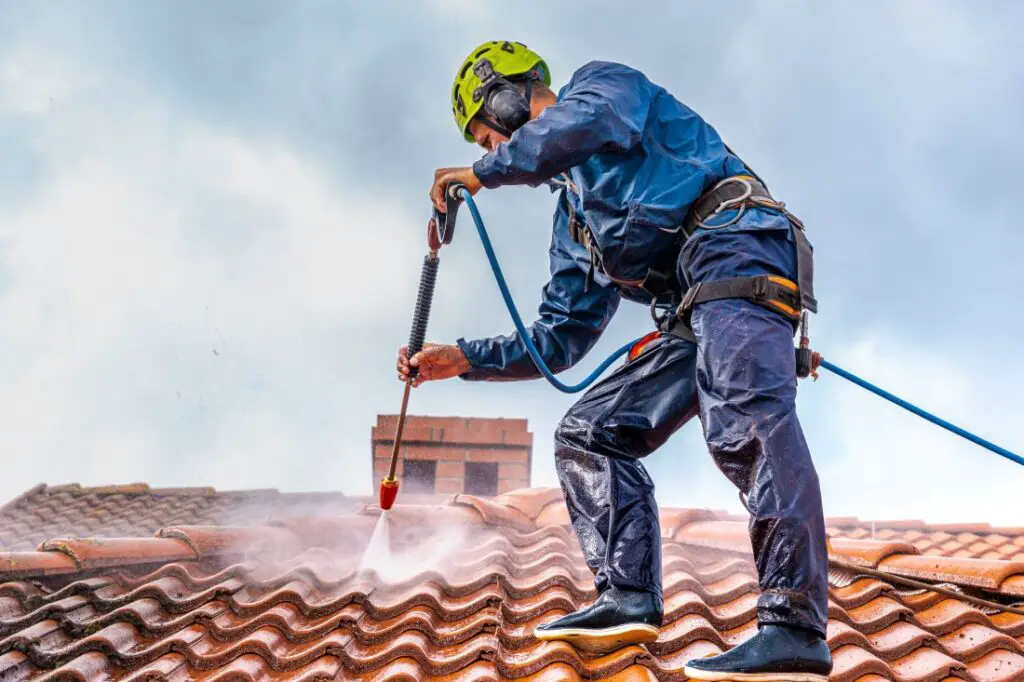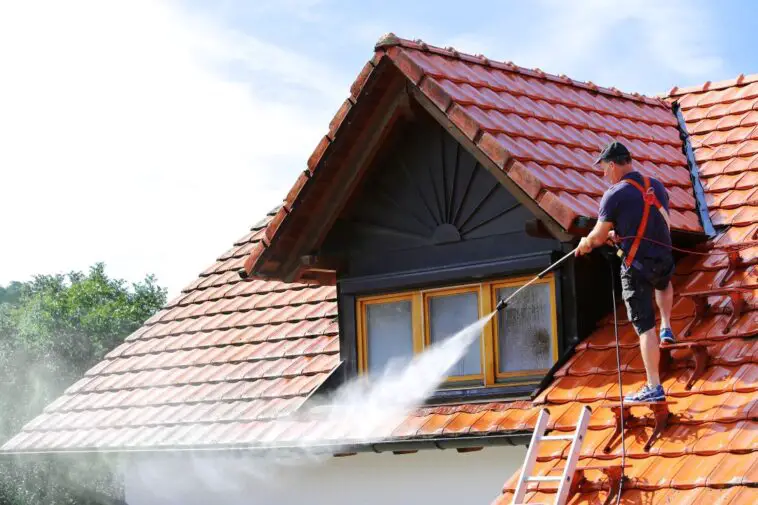If your roof looks dirty and worn, pressure washing may seem like a quick fix. But there are right and wrong ways to clean your roof with a pressure washer. Improper pressure washing can damage your roof, leading to leaks or premature replacement.
Save yourself headaches and money by following these dos and don’ts before cleaning your roof. With these tips, you can take on this project yourself with confidence.
Why Roof Cleaning Is Essential?
Regular roof cleaning extends the lifespan of roofing materials by preventing damage from moss, lichens, and debris buildup. It removes hazards, like falling branches and other debris. Moreover, it deters pest infestations and leaks that can help prevent untimely roof replacement or other extensive repairs.
Through routine maintenance, roofs are kept looking their best, giving homeowners the pride of ownership and increasing a home’s value. Now that we know the importance of roof maintenance, let’s look at how it’s done correctly.
What To Do
1. Inspect Your Roof Thoroughly
Before you begin pressure washing your roof, conduct a thorough inspection. Look for damaged or loose shingles, flashing, or faulty vents that may need repair before cleaning.
Determining if your roof is suitable for pressure washing can be a challenging task unless you possess experience in assessing roof damage. Consider consulting professional roof inspectors like those at Holliday’s Pressure Washing Services to evaluate your roof’s condition before attempting to pressure wash it yourself.
2. Use The Right Equipment
Invest in a pressure washer with an adjustable nozzle and pressure setting. Opt for a lower pressure setting to control the water pressure easily to avoid roof surface damage. Choose one with an adjustable PSI between 1,200 and 2,000, as this range is typically safe and effective for removing dirt and debris from roofing materials.
3. Choose The Right Cleaning Solution
Select an appropriate cleaning solution for your roof type. Follow the manufacturer’s guidelines for the cleaning solution and dilution ratios. Generally, a mixture of water, mild detergent, and oxygen bleach is safe for various types of roofs. It is especially effective in removing dirt, algae, and moss.
4. Work From The Top Down
To minimize damage as you clean, wash at the top of the roof and systematically work downward in sections. This approach allows dirt and debris to flow away from areas you’ve already cleaned. Complete one section at a time to prevent the need to walk over freshly cleaned areas, protecting the roof surface.
5. Use Gentle And Consistent Pressure
Maintain a steady and gentle pressure while washing your roof. Avoid excessive force, as high pressure can damage shingles or force water under them, leading to leaks. Keep the nozzle at a safe distance from the roof’s surface.
6. Wear Protective Gear
When working at heights, make safety your priority by wearing protective equipment—like non-slip shoes, goggles, and a harness—to prevent accidents.
7. Rinse Thoroughly
After cleaning, rinse your roof thoroughly with clean water to remove any remaining cleaning solution. Chemicals left on the surface may pose potential damage.

What Not To Do
1. Don’t Use High Pressure
Using high-pressure settings on your pressure washer can cause severe damage to your roof, such as stripping away granules from your shingles and harming the underlying structure.
Avoid using pressure settings above 2,000 PSI, as this setting can strip away granules from shingles and damage the underlying structure.
2. Don’t Use Harsh Chemicals
Avoid using strong chemical cleaners or bleach on your roof, as they can cause discoloration and harm the environment. Stick to mild, eco-friendly cleaning solutions to protect your roof and surrounding landscape.
3. Don’t Walk On Wet Or Algae-Covered Roofs
Walking on a wet or algae-covered roof can be extremely dangerous. Always exercise caution, and avoid unnecessary foot traffic on the roof during and after cleaning.
4. Don’t Ignore Safety Precautions
It’s crucial to take safety measures when pressure washing roofs to prevent falls that could lead to serious injury. Never overlook precautions even when you’re rushed or fatigued, as neglecting safety when working at heights poses substantial risks.
5. Don’t Rush the Process
Take your time when pressure washing your roof. Rushing through the job can lead to missed spots and ineffective cleaning. Properly cleaning your roof requires patience and attention to detail.
6. Don’t Neglect Post-Cleaning Maintenance
Once your roof is clean, consider applying a roof treatment or coating to prevent future moss and algae growth. Schedule regular maintenance at least once every three months to extend the life of your roof and keep it looking its best.
Conclusion
Pressure washing your roof may be a daunting task, but it’s one of the ways to restore its appearance and add years of life if done correctly. Always inspect your roof and use the right equipment with care.
Follow the recommended dos and don’ts for safe and effective roof cleaning. Taking the time to pressure wash your roof correctly will provide long-lasting benefits that make the effort worthwhile.




